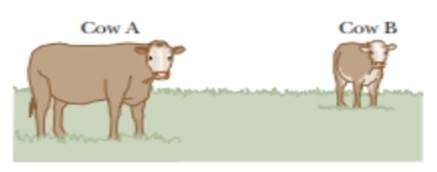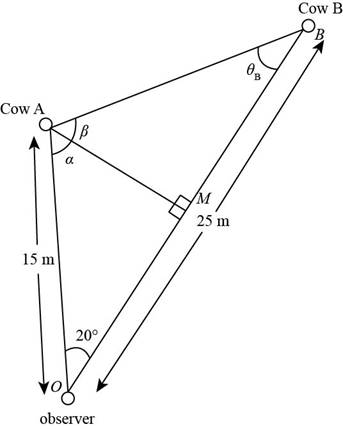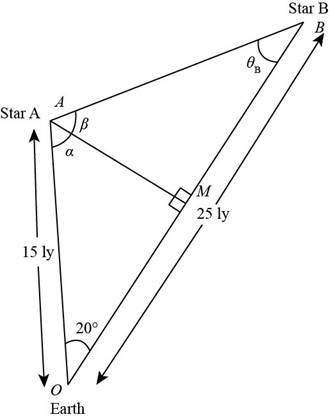
Concept explainers
You stand in a flat meadow and observe two cows (Fig. P1.73). Cow A is due north of you and 15.0 m from your position. Clow B is 25.0111 from your position. From your point of view, the angle between cow A and cow H is 20.0°, with cow B appearing to the right of cow A. (a) How far apart are cow A and cow B? (b) Consider the view seen by cow A. According to this cow, what is the angle between you and cow B? (c) Consider the view seen by cow B. According to this cow, what is the angle between you and cow A? Hint: What does the situation look like to a hummingbird hovering above the meadow? (d) Two stars in the sky appear to be 20.0° apart. Star A is 15.0 ly from the Earth, and star B. appearing to the right of star A. is 25.0 ly from the Earth. To an inhabitant of a planet orbiting star A. what is the angle in the sky between star B and our Sun?

Figure P1.73 Your view of two cows in a meadow. Cow A U due north of you. You must rotate your eyes through an angle of 20.0° to look from cow A to cow B.
(a)
The distance between cow
Answer to Problem 1.73AP
The distance between cow
Explanation of Solution
Given data: The Cow
Consider the following figure.

Figure (1)
The expression for the distance between cow
Substitute
Conclusion:
Therefore the distance between cow
(b)
The angle between observer and the cow B.
Answer to Problem 1.73AP
The angle between observer and the cow B is
Explanation of Solution
Given data: The Cow
From figure (1),
In triangle
Substitute
Thus the value of the
In triangle
Substitute
The value of the
In triangle
Substitute
Thus the value of the
The expression for the angle between observer and the cow
Substitute
Conclusion:
Therefore the angle between observer and the cow B is
(c)
The angle between the observer and cow
Answer to Problem 1.73AP
The angle between the observer and cow
Explanation of Solution
Given data: The Cow
The expression for the angle between the observer and cow
Substitute
Conclusion:
Therefore the angle between the observer and cow
(d)
The angle between the star
Answer to Problem 1.73AP
The angle between the star
Explanation of Solution
Given data: The star
Consider the following figure.

Figure (2)
The expression for the distance between star
Substitute
Thus the value of
In triangle
Substitute
Thus the value of the
In triangle
Substitute
The value of the
In triangle
Substitute
Thus the value of the
The expression for the angle between earth and the star
Substitute
Conclusion:
Therefore, the angle between the star
Want to see more full solutions like this?
Chapter 1 Solutions
EBK PHYSICS FOR SCIENTISTS AND ENGINEER
Additional Science Textbook Solutions
Fundamentals Of Thermodynamics
HUMAN ANATOMY
Cosmic Perspective Fundamentals
Campbell Essential Biology (7th Edition)
Chemistry: A Molecular Approach (4th Edition)
- Question B3 Consider the following FLRW spacetime: t2 ds² = -dt² + (dx² + dy²+ dz²), t2 where t is a constant. a) State whether this universe is spatially open, closed or flat. [2 marks] b) Determine the Hubble factor H(t), and represent it in a (roughly drawn) plot as a function of time t, starting at t = 0. [3 marks] c) Taking galaxy A to be located at (x, y, z) = (0,0,0), determine the proper distance to galaxy B located at (x, y, z) = (L, 0, 0). Determine the recessional velocity of galaxy B with respect to galaxy A. d) The Friedmann equations are 2 k 8πG а 4πG + a² (p+3p). 3 a 3 [5 marks] Use these equations to determine the energy density p(t) and the pressure p(t) for the FLRW spacetime specified at the top of the page. [5 marks] e) Given the result of question B3.d, state whether the FLRW universe in question is (i) radiation-dominated, (ii) matter-dominated, (iii) cosmological-constant-dominated, or (iv) none of the previous. Justify your answer. f) [5 marks] A conformally…arrow_forwardSECTION B Answer ONLY TWO questions in Section B [Expect to use one single-sided A4 page for each Section-B sub question.] Question B1 Consider the line element where w is a constant. ds²=-dt²+e2wt dx², a) Determine the components of the metric and of the inverse metric. [2 marks] b) Determine the Christoffel symbols. [See the Appendix of this document.] [10 marks] c) Write down the geodesic equations. [5 marks] d) Show that e2wt it is a constant of geodesic motion. [4 marks] e) Solve the geodesic equations for null geodesics. [4 marks]arrow_forwardPage 2 SECTION A Answer ALL questions in Section A [Expect to use one single-sided A4 page for each Section-A sub question.] Question A1 SPA6308 (2024) Consider Minkowski spacetime in Cartesian coordinates th = (t, x, y, z), such that ds² = dt² + dx² + dy² + dz². (a) Consider the vector with components V" = (1,-1,0,0). Determine V and V. V. (b) Consider now the coordinate system x' (u, v, y, z) such that u =t-x, v=t+x. [2 marks] Write down the line element, the metric, the Christoffel symbols and the Riemann curvature tensor in the new coordinates. [See the Appendix of this document.] [5 marks] (c) Determine V", that is, write the object in question A1.a in the coordinate system x'. Verify explicitly that V. V is invariant under the coordinate transformation. Question A2 [5 marks] Suppose that A, is a covector field, and consider the object Fv=AAμ. (a) Show explicitly that F is a tensor, that is, show that it transforms appropriately under a coordinate transformation. [5 marks] (b)…arrow_forward
- No chatgpt pls will upvote Iarrow_forwardHow would partial obstruction of an air intake port of an air-entrainment mask effect FiO2 and flow?arrow_forward14 Z In figure, a closed surface with q=b= 0.4m/ C = 0.6m if the left edge of the closed surface at position X=a, if E is non-uniform and is given by € = (3 + 2x²) ŷ N/C, calculate the (3+2x²) net electric flux leaving the closed surface.arrow_forward
- No chatgpt pls will upvotearrow_forwardsuggest a reason ultrasound cleaning is better than cleaning by hand?arrow_forwardCheckpoint 4 The figure shows four orientations of an electric di- pole in an external electric field. Rank the orienta- tions according to (a) the magnitude of the torque on the dipole and (b) the potential energy of the di- pole, greatest first. (1) (2) E (4)arrow_forward
 Principles of Physics: A Calculus-Based TextPhysicsISBN:9781133104261Author:Raymond A. Serway, John W. JewettPublisher:Cengage Learning
Principles of Physics: A Calculus-Based TextPhysicsISBN:9781133104261Author:Raymond A. Serway, John W. JewettPublisher:Cengage Learning Physics for Scientists and EngineersPhysicsISBN:9781337553278Author:Raymond A. Serway, John W. JewettPublisher:Cengage Learning
Physics for Scientists and EngineersPhysicsISBN:9781337553278Author:Raymond A. Serway, John W. JewettPublisher:Cengage Learning Physics for Scientists and Engineers with Modern ...PhysicsISBN:9781337553292Author:Raymond A. Serway, John W. JewettPublisher:Cengage Learning
Physics for Scientists and Engineers with Modern ...PhysicsISBN:9781337553292Author:Raymond A. Serway, John W. JewettPublisher:Cengage Learning An Introduction to Physical SciencePhysicsISBN:9781305079137Author:James Shipman, Jerry D. Wilson, Charles A. Higgins, Omar TorresPublisher:Cengage Learning
An Introduction to Physical SciencePhysicsISBN:9781305079137Author:James Shipman, Jerry D. Wilson, Charles A. Higgins, Omar TorresPublisher:Cengage Learning College PhysicsPhysicsISBN:9781305952300Author:Raymond A. Serway, Chris VuillePublisher:Cengage Learning
College PhysicsPhysicsISBN:9781305952300Author:Raymond A. Serway, Chris VuillePublisher:Cengage Learning College PhysicsPhysicsISBN:9781285737027Author:Raymond A. Serway, Chris VuillePublisher:Cengage Learning
College PhysicsPhysicsISBN:9781285737027Author:Raymond A. Serway, Chris VuillePublisher:Cengage Learning





